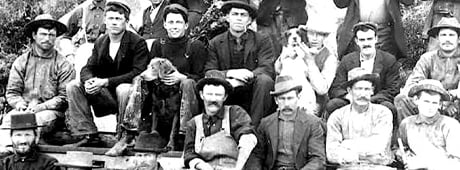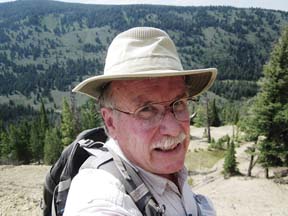No products in the cart.
War Eagle Mountain

Old Mines High above Silver City
By Ray Brooks
I knew the rough road was public, so I ignored a “Private” sign and opened a sheepherder gate in a fence to drive into the remains of the once-bustling 1860s ghost town of Flint, seven miles south of Silver City. Uh-oh, there were residents. I parked by an ancient ore-concentrating mill and my wife Dorita and I met a pleasant man who explained that Flint had been owned by his family since the 1800s. This was back in 2006, and given that Idaho adopted a stricter trespassing law in 2018, I now would suggest that folks leave Flint to its owners. On that day, I resisted asking for a tour of what I knew was the historic Rising Star Mine’s ore-concentrating mill. Rich gold and silver ores had been mined in the Flint area but zinc and antimony in the silver ores caused them to yield only a fraction of their riches after milling and amalgamation. This led to the bankruptcy of early owners.
I asked the man if the road through Flint still connected to Silver City. He assured us it was a “pretty good” road that went over War Eagle Mountain. The road was indeed pretty good although tree limbs and brush narrowed it in places to the width of a hiking trail. By the time Dorita and I reached War Eagle Mountain, I had scratched the hell out of my SUV’s paint. We car-camped on a ridge named Stormy Hill a mile or so from the summit, among scattered, wind-bent mountain mahogany, with a view down into Silver City. The next morning we explored some of the old mines on the south side of the mountain before finding our way down the north side on another rough public road.
War Eagle Mountain was named during the Civil War. I strongly suspect it came from a bald eagle named Old Abe that was adopted by a Wisconsin regiment, which became famous as “The War Eagle.” My first visit to War Eagle Mountain had been with my parents in 1965. At the time, I was most impressed by the old mines there and decided I should visit again. It had taken me forty-one years to get back, although recently I’ve returned a couple more times.
Rich gold-silver quartz veins were first found on the 8,051-foot mountain in 1863, soon after a party of prospectors from Boise Basin towns discovered placer gold on May 18 of that year on Jordan Creek, about seven miles below present-day Silver City. War Eagle Mountain towers above Jordan Creek to the east. Within a year, the deposits on Jordan Creek were mostly played out, while quartz-mining on War Eagle Mountain became increasingly important.
One of the first mines established on the mountain was the Morning Star, whose ore returned values that exceeded any strikes in the now-fabled Comstock Lode mines of Virginia City, Nevada. An early report on the mines of War Eagle claimed they had “the richest and most wonderful deposit of gold and silver in quartz yet discovered in the United States.”
Within a few years, thirty active gold and silver mines were located on the mountain. Speculators had filed claims on seemingly every possible rocky outcrop and then sold them to eager investors in Portland, San Francisco, and New York City. For a few months, miners reduced the ore to sand with sledgehammers and hand mortars, and then panned amazingly rich values out of a few hundred pounds of that sand. This evidence of incredible gold and silver riches justified bringing expensive and heavy stamp mills into the remote region via steamboats that traveled up the Columbia River, and then by wagon from Umatilla, Oregon, or directly from the Northern California coast on wagons. Heavier loads such as steam boilers and their pistons to run the stamp mills and to pump water from mine shafts were brought in on skids during winter.
This content is available for purchase. Please select from available options.
Purchase Only
Purchase Only


3 Responses to War Eagle Mountain
Sarah Ivey Wilson -
at
My family has a lot of history in silver city. We put my mom and dads ashes above the flint mine. Her brother that died at 3 months when my granddad was working at the mine and my mom’s mothers brother is also up there. Her family still has a ranch on flint creek. And our family has a house in silver city. We would go to silver almost every weekend when I was little and dad would work on the house.
Judy Barnes -
at
Fantastic, Ray!! I love your descriptive accounts…it’s as if I were there with you. You are indeed blessed to be able to hike to these locations…not an easy feat for many of us. BTW, what were the odds of Art blasting off his hand just to open that beer! Wow, what an experience for you!
Steve Tupy -
at
I have 150,000 shares of war eagle mining co, from 1956 idlike to know if it worth any thing